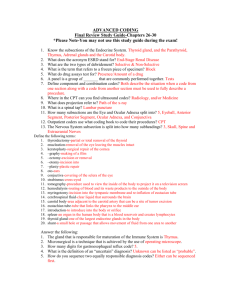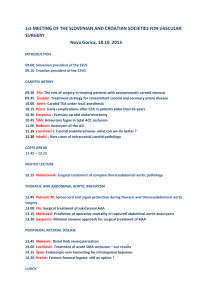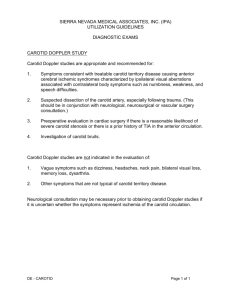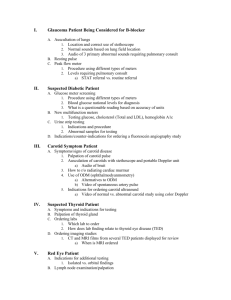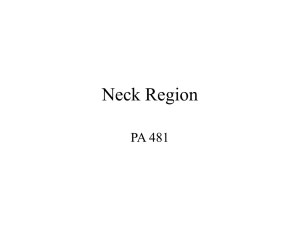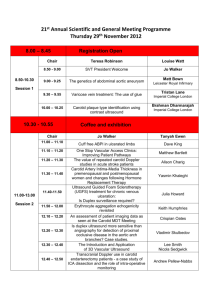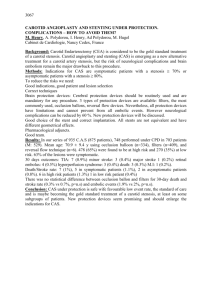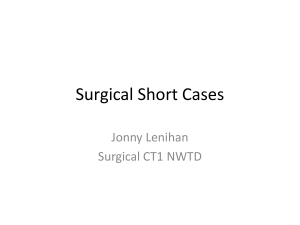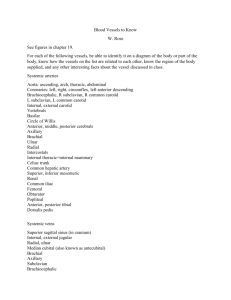Neck Triangle Lecture notes
advertisement
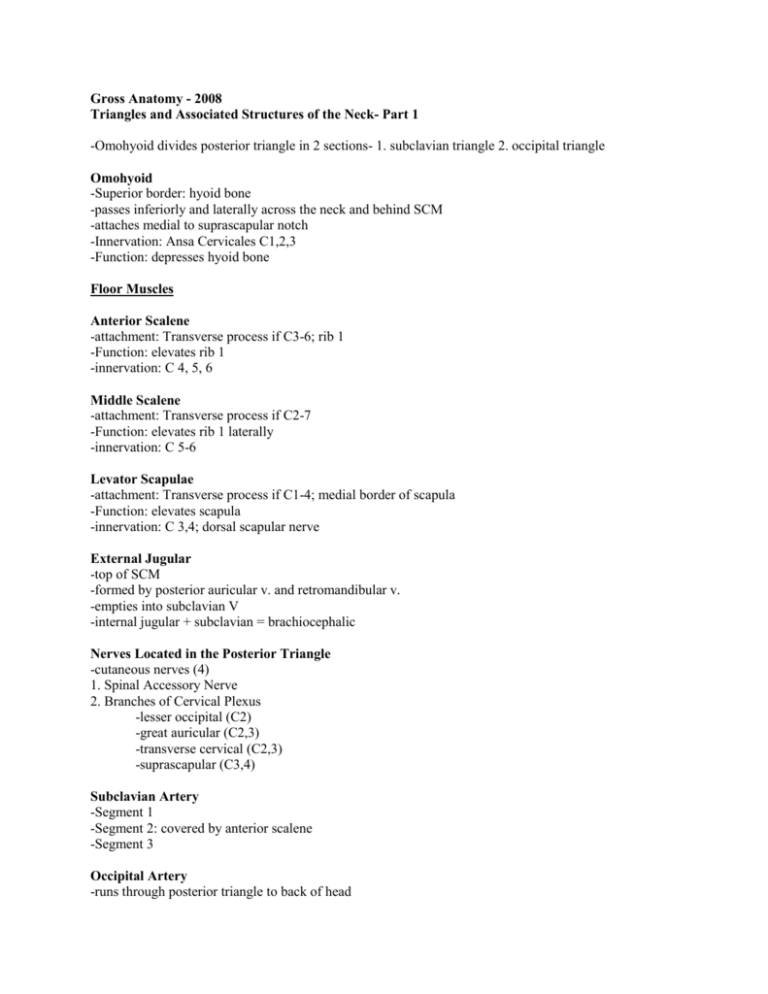
Gross Anatomy - 2008 Triangles and Associated Structures of the Neck- Part 1 -Omohyoid divides posterior triangle in 2 sections- 1. subclavian triangle 2. occipital triangle Omohyoid -Superior border: hyoid bone -passes inferiorly and laterally across the neck and behind SCM -attaches medial to suprascapular notch -Innervation: Ansa Cervicales C1,2,3 -Function: depresses hyoid bone Floor Muscles Anterior Scalene -attachment: Transverse process if C3-6; rib 1 -Function: elevates rib 1 -innervation: C 4, 5, 6 Middle Scalene -attachment: Transverse process if C2-7 -Function: elevates rib 1 laterally -innervation: C 5-6 Levator Scapulae -attachment: Transverse process if C1-4; medial border of scapula -Function: elevates scapula -innervation: C 3,4; dorsal scapular nerve External Jugular -top of SCM -formed by posterior auricular v. and retromandibular v. -empties into subclavian V -internal jugular + subclavian = brachiocephalic Nerves Located in the Posterior Triangle -cutaneous nerves (4) 1. Spinal Accessory Nerve 2. Branches of Cervical Plexus -lesser occipital (C2) -great auricular (C2,3) -transverse cervical (C2,3) -suprascapular (C3,4) Subclavian Artery -Segment 1 -Segment 2: covered by anterior scalene -Segment 3 Occipital Artery -runs through posterior triangle to back of head Anterior Triangle and Its Subdivisions 1. Submental Triangle- unpaired 2. Submandibular triangle- under mandible 3. Muscular triangle- trachea; divided by omohyoid 4. Carotid triangle- carotid pulse Submental Triangle: Digastric Muscle -2 bellies; tendinous intersection -Posterior Belly: Innervation: Facial N Function: pulls hyoid posterior and up -Anterior Belly Innervation: N to Mylohyoid Function: pulls hyoid anterior and up Mylohyoid Muscle -innervation: N to Mylohyoid -Function: elevates mylohyoid bone Stylohyoid Muscle -innervation: Facial Nerve -Function: moves hyoid posterior and up Gross Anatomy 1. Muscle Anatomy: including attachments, functions, loss of function, and innervations. 2. Nerve Anatomy: including origin, path, destination, location, function, injury and loss of function. 3. Vasculature: including origin, path, destination of veins and arteries, and collateral 4. circulation. 5. Lymphatics: lymphatic drainage pattern, major lymphatic vessels within a region and clusters of lymph nodes Carotid Triangle Boundaries: portion of carotid muscles -posterior gastric -SCM -superior belly of omohyoid Floor - portions of thryohyoid m - hypoglossus - -middle and inferior constrictors of the pharynx Contains -carotid sheath: Internal carotid A, Internal Jugular V, Vagus N, Hypoglossal N - External carotid A. with branches - Deep cervical lymph nodes: jogulodigastric node, jogulomyohyoid node Carotid System - Common Carotid Bifurcation- at C3- C4 on top of thyroid cartliage Carotid sinus Carotid body - Internal Carotid – passing through the neck (no branches in neck) - External Carotid –(total of 8 branches: 2 terminal branches, 6 main branches) Superior thyroid artery- goes to superior thyroid. Has tiny brachnes on top that becom superior laryngeal Ascending pharyngeal artery- travels to pharyngeal muscles, ascends medially Lingual artery- travels to tongue( soft palate, floor of tongue, mandibula, and sublingual glands) Facial artery- travels to submandibular gland, and supplies arteries to the face Occipital artery- supples back of posterior aspect of head (branches to SCM, auricular region, etc) Posterior auricular artery- to ear and parotid gland Superficial temporal artery- (terminal branch)- tranvels to side of head, temporalis muscle, parotid gland, transverse facial muscle Maxillary artery- (terminal branch) is found deep behind mandibula. - Carotid Sinus- innervated by glossopharyngeal - a dilation of the lower end of the internal carotid - the tunica intima is thinner and adventitia is thicker - the adventitia includes nerve endings (mainly CN IX) - functions as a baroreceptor - Carotid Body - a vascular organ; an arterial chemoreceptor (samples blood and monitors CO2 and pH levels) - a reddish-brown mass found at the bifurcation - innervation by CN IX, CN X and pre-ganglionic sympathetic (post-ganglionics are in the carotid body) - Anatomoses between Enternal and Internal carotid prevents major complications when ligation of the external carotid artery occurs - Nerves found in the carotid triangle Hypogloss an. Descending branch & Ansa cervicalis - Nerves Vagus.: 3 branches( pharyngeal branch to posterior region of pharynx, branch to carotid body, cardiac branches to plexus) superior laryngeal- splits into internal and external branch external laryngeal- innervates constrictor muscles internal laryngeal- runs with superior laryngeal artery Arrangement of Viscera in the Anterior Neck Thyroid- needed for thyroxin which is important in metabolism The thyroid is divided into two lobs with an isthmus inbetween. Arteries: Superior thyroid A (supplies superior portion of gland), Inferior thyroid A (off of the thyrocervical trunk off of subclavian, and it supplies posterior aspect of thyroid) Veins- Superior thyroid vein into IJV, Middle thyroid vein into IJV, Inferior thyroid vein into brachiocephalic. **2 arteries, 3 veins** except when you have an extra artery called the thyroid ima (branches off of brachiocephalic artery) Pyramidal lobe- extra lobe caused by incomplete descent of thyroid. Can cause cyst and fistulas. Parathyroid gland- 4 total (2 superior and 2 inferior) on the posterior side of the thyroid. Blood is supplied inferior thyroid artery.
